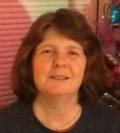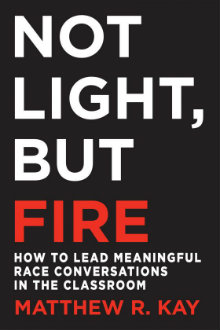Leading Meaningful Race Conversations in Class
Not Light, But Fire: How to Lead Meaningful Race Conversations in the Classroom
By Matthew R. Kay
(Stenhouse, 2018 – Learn more)

In this manifesto of sorts, Matthew Kay builds on a modification of Frederick Douglas’ call to action in 1852 “. . . It is not light that is needed, but fire” (quoted on pg. 4).
In the first part of the book Kay discusses the logistics – giving specific examples from his own classroom – of preparing our students and our classroom environment for open, authentic conversations about hard topics and problems growing out of race issues that face our world.

Kay reminds us that where we spend our time indicates to students what is most important to us, and that giving time each day for important conversations (5 minutes), shows students that their real lives matter to us (p. 29).
His introduction is followed by chapters that focus on discussion routines, common mistakes that can lead to trouble, types of conflict in discussion, and the careful selection of our purpose for each choice that we make in this process.
How Kay brings difficult conversations to his classroom
In the second part of Not Light, But Fire, Kay goes through specific units and teaching questions that he has used in his class. We are essentially observing his class as he guides his students through difficult, thought-provoking conversations on race.
Kay admits that both his teaching environment (he’s an English teacher at a magnet partnership high school with threaded themes and an administration that supports a less traditional learning environment) and his own race, contribute to his ability to have some of these discussions, such as basing the questions within the school’s themes and using literature to drive the discussions.
How other teachers can address difficult topics
He does make some suggestions on how other teachers might address these conversations. For instance, he gives the example of how he leads a discussion on the “N-word,” beginning this conversation by writing the word very large on his board and asking students to respond to their relationship/feelings/experiences surrounding this word. He suggests that if you are white, that you might only write the first letter of the word on the board to start the discussion.
In our current educational atmosphere, conversations of this type present a certain risk. Teachers must carefully plan, think through, and make sure that the environment is right, and that they have the right purpose, prompts, and structures in place before they consider such conversations.
While I believe we need to tread carefully in this area, and I’m not sure how to consistently drive this type of discussion within science and math curriculum, I also think that it is unwise to hide behind the risk and ignore the elephant that still exists in our society.
Read an excerpt from Not Light, But Fire here at MiddleWeb
Helping prepare students for the world beyond school
Kay makes the point that “If, in our conversations, we are preoccupied with the shedding of predictable light, our students will be that much less equipped to handle fire when the moment comes” (p. 111), and thus as a society our progress around race relations may be stymied.
This is a well written, concise (although not short) and thought-provoking book that challenges teachers to move beyond traditional classroom topics and discussions and “. . . help students to develop healthy habits of both mind and discourse that will serve them for the rest of their lives” (p. 5) as they tackle the complex problems of our real world as adults.
I doubt that race discussions of this magnitude will be commonplace anytime soon, but they never will be if we don’t at least consider the mission of this book to move the conversation forward and thoughtfully reflect on our teaching and our students’ learning.
Dr. Laura Von Staden is a middle school Special Education Specialist in Tampa, Florida. She serves on numerous committees both at her school and within her district and works closely with the local university where she is a Professional Practice Partner and master mentor. Von Staden also facilitates both online and face-to-face professional development and writes curriculum for her school district.





























